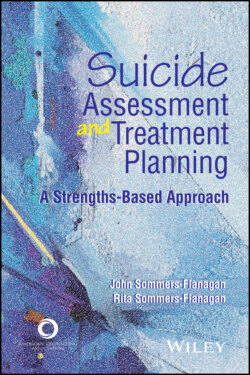Читать книгу Suicide Assessment and Treatment Planning - John Sommers-Flanagan - Страница 41
Understanding Suicide Competence
ОглавлениеSuicide competence refers to what clinicians need to know and do to provide professional services to clients at risk for suicide. In a general sense, suicide competencies encompass three parts of a symphony that includes many different notes, movements, and melodies. Like all competency models (Cramer et al., 2013), these three parts include the following:
Self-awareness and attitudes. This includes developing greater awareness of your own attitudes toward suicide and how your attitudes, beliefs, and personal values might play out in specific clinical scenarios. Exploring your attitudes toward suicide helps you cope with personal and emotional reactions while maintaining a therapeutic relationship and implementing state-of-the-art suicide assessment and treatment planning procedures.
Knowledge acquisition. Foundational knowledge includes information on effective assessment and treatment and an understanding of ethical and legal standards. Having greater foundational knowledge of suicide helps increase your confidence and frees you to experience and express compassion for clients struggling with suicidality.
Skill development. This refers to learning and practicing specific skills and strategies, including (a) comfortably asking about suicide; (b) empathically interacting with clients who are experiencing depression, hopelessness, and irritability; (c) engaging in collaborative assessment; (d) developing collaborative treatment and safety plans; (e) implementing specific interventions; and (f) documenting clinical decision-making.
At the beginning and throughout the symphony of suicide-related self-awareness, knowledge, and skill acquisition, there is a steady drumbeat of ethical and legal standards in the background. This drumbeat will sometimes distract you; other times it will provoke anxiety. On good days, local and national practice standards will guide your work with clients who are suicidal. Practice standards include knowledge of ethical decision-making models, breaching confidentiality, documentation, and much more.
Within the counselor education discipline, there is little guidance or consensus regarding suicide assessment and treatment competence. The 2016 Council for Accreditation of Counseling and Related Educational Programs (CACREP) Standards (CACREP, 2016) include two statements pertaining to required counseling coursework in “Suicide prevention models and strategies” (Section 2.F.5.l.) and “Procedures for assessing risk of aggression or danger to others, self-inflicted harm, or suicide” (Section 2.F.7.c.). Similarly, the ACA Code of Ethics (American Counseling Association [ACA], 2014) mentions suicide once, but only in the context of the storage and disposal of records. Standard C.2.b. of the Code offers general guidance for “New Specialty Areas of Practice.” It reads: “Counselors practice in specialty areas new to them only after appropriate education, training, and supervised experience . . . counselors take steps to ensure the competence of their work and protect others from possible harm.” Although working with suicidality is not an identified practice specialty, counselors need specialized education, training, and supervised experience in suicide assessment and treatment.
Similar to counselor education, other professional disciplines also offer little guidance regarding suicide-related competence. The American Psychological Association (2010) does not use the words suicide or suicidal in its accreditation standards or ethics code, but it does have a helpful informational and resource-oriented website (see https://www.apa.org/topics/suicide/). Although the American Academy of Child and Adolescent Psychiatry has a practice parameter for the assessment and treatment of children and adolescents with suicidal behavior, its guidance has not been revised since 2001. Similar to ACA and the American Psychological Association, the National Association of Social Workers (2017) provides links to documents about suicide prevention and treatment but offers no formal training guidelines.
Recently, the American School Counselor Association took a step forward in this area, publishing a “Suicide Risk Assessment Position Statement” (Sara Carpenter, personal communication, July 3, 2020). This statement clarifies the role of school counselors as part of a collaborative care team that uses evidence-supported strategies and always reports students’ elevated suicide risk to parents, guardians, or, in cases of caregiver abuse or neglect, child protective services (American School Counselor Association, 2020).
In contrast to the sparse mention of specific training protocols linked to professional organizations, the scientific literature on suicide assessment, treatment planning, and interventions is immense. At the time of this writing, we found more than 32,000 publications on PsycINFO with suicide or suicidal in the title. Keeping up with the professional literature on suicide could be a full-time job.
Fortunately, suicide researchers and professional organizations frequently summarize the literature. Several researchers and organizations have described essential suicide assessment and treatment competencies. Most prominently, the American Association of Suicidology (AAS; 2010), a national organization dedicated to studying suicide, identified 24 competencies organized under eight broad categories. Several additional competency guidelines and models exist. To simplify the smorgasbord of competencies available, Cramer and colleagues (2013) distilled principles from five different competency guides (including AAS) into 10 core competencies. Even simplified, the 10 core competencies constitute a wide array of attitudes, knowledge, skills, and practice standards. In this chapter, we provide an initial overview; throughout the rest of this book we offer case vignettes, extended case examples, and commentary relevant to the 10 core competencies.
